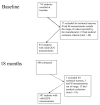Menarchal status and calf circumference predict calcaneal ultrasound measurements in girls
- PMID: 17367724
- PMCID: PMC4996071
- DOI: 10.1016/j.jadohealth.2006.11.135
Menarchal status and calf circumference predict calcaneal ultrasound measurements in girls
Abstract
Purpose: The purpose of this study was to predict calcaneal QUS measurements in healthy adolescent females as a function of anthropometric measures, pubertal stage and menarchal status.
Methods: This was a secondary data analysis from a 2-year intervention designed to increase bone accretion. Simple Pearson correlation and Spearman's rank correlation analyses, followed by linear stepwise regression analyses were conducted.
Setting: 12 middle schools.
Participants: 672 female students, baseline; 587 students at 18 months.
Main outcome measure: Calcaneal stiffness index (SI) by quantitative ultrasound.
Results: Eighty percent of the subjects were premenarchal at baseline; 33% at 18 months. Although SI correlated with self-assessed pubic hair (rho = .21) and menarchal status (rho = .23, p < .01 for both) at baseline, the model for predicting SI included menarchal status, not pubic hair, and calf circumference, controlling for BMI (R(2) = .22, p < .01). At 18 months, SI correlated with self-assessed pubic hair (rho = .21) and menarchal status (rho = .25, p < .01 for both). The best model to predict SI included calf circumference and pubic hair stage (R(2) = .14, p < .01), and not menarchal status as 67% of the subjects at 18 months were postmenarchal.
Conclusions: In research assessing calcaneal SI in groups of adolescents, assessment of pubertal stage could be replaced with menarchal status and calf circumference when the majority of subjects are premenarchal. When the majority is postmenarchal, pubic hair stage and calf circumference together may be used to assess for pubertal maturation without menstrual status.
Figures
References
-
- Osteoporosis prevention, diagnosis and therapy; National Institutes of Health Consensus Development Conference Statement; Washington, D.C. March 27–29, 2000.
-
- Randell AG, Nguyen TV, Bhalerao N, Silverman SL, et al. Deterioration in quality of life following hip fracture: a prospective study. Osteoporos Int. 2000;11:460–6. - PubMed
-
- Gilsanz V, Gibbens DT, Roe TF, et al. Vertebral bone density in children: effect of puberty. Radio. 1988;166:847–50. - PubMed
-
- Theintz G, Buchs B, Rizzoli R, et al. Longitudinal monitoring of bone mass accumulation in healthy adolescents: evidence for marked reduction after 16 years of age at the levels of lumbar spine and femoral neck in female subjects. J Clin Endocrinol Metab. 1992;75:1060–5. - PubMed
-
- Slemenda CW, Reister TK, Hui SL, et al. Influences on skeletal mineralization in children and adolescents: evidence for varying effects of sexual maturation and physical activity. J Pediatr. 1994;125:201–207. - PubMed
Publication types
MeSH terms
Grants and funding
LinkOut - more resources
Full Text Sources
Medical


